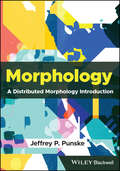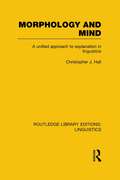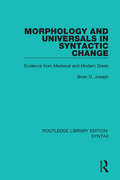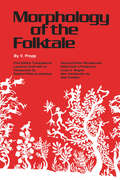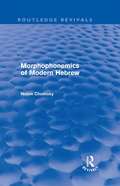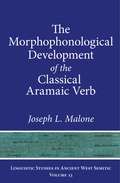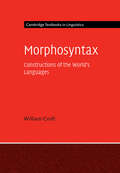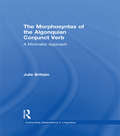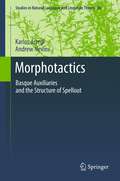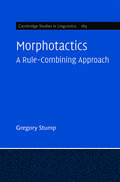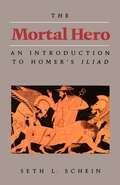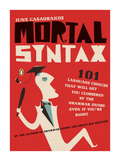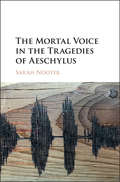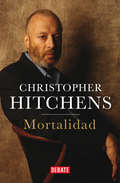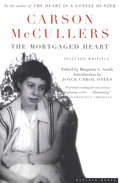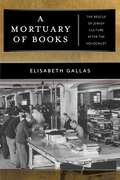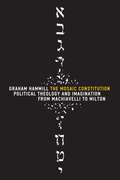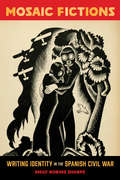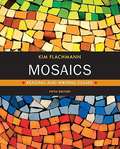- Table View
- List View
Morphology: A Distributed Morphology Introduction
by Jeffrey P. PunskeThe first comprehensive morphology textbook written in the framework of Distributed Morphology, firmly grounded in cross-linguistic theory Distributed Morphology is the theoretical framework that views morphology as syntactic, proposing that there is no divide between the construction of words and the construction of sentences. The first text of its kind, Morphology: A Distributed Morphology Introduction provides a thorough overview of Distributed Morphology using data and problem sets from a diverse selection of the world's languages. Divided into two parts, this valuable resource begins by describing the basics of morphology and then moves into an exploration of more advanced topics in morphology including morphosyntactic operations, cyclic derivation, the Mirror Principle, and non-compositional language. Each chapter includes a glossary of key terms, learning objectives, further readings, and illustrative examples to reinforce learning. Exercises and problem sets encourage students to develop their understanding and build confidence in the application of theory to practice. Through this valuable text, students will develop comprehension in morphological parsing and glossing, the concept of the lexicon, the different types of morphemes, the idea of paradigms, the basic practice of morphological analysis, and more. Offering detailed yet accessible coverage of morphological theory from the perspective of Distributed Morphology, this textbook: Introduces the methodology used in morphology, the basic assumptions of Distributed Morphology, and key concepts from lexical grammatical approaches to language Covers essential phonology, feature interaction, paradigms as linguistic objects, core ideas of syntax and syntactic derivation, and derivation and inflection in Distributed Morphology Includes a Quick Reference Guide with glossing abbreviations from the Leipzig Glossing Rules, a full IPA chart with instructions, and charts of phonological features Provides access to a companion website containing solutions to problem sets and additional instructor resources Morphology: A Distributed Morphology Introduction is the ideal textbook for advanced undergraduates and graduate students in morphology courses or with an interest in specializing in morphology. Offering students an unparalleled overview of this growing field of morphology, this text will ensure that developing morphologists are well-equipped to employ the latest methods in Distributed Morphology to their own research and study.
Morphology and Mind: A Unified Approach to Explanation in Linguistics (Routledge Library Editions: Linguistics)
by Christopher J. HallThe central concern of this book is the explanation of linguistic form. It examines in detail certain cross-linguistic patterns in morphological systems, providing unified explanations of the observation that suffixes predominate over prefixes and the correlation between affix position and syntactic head position. The explanation of the suffixing preference is one which appeals to principles of language processing, tempered by cognitive constraints underlying language change. These factors, coupled with generative morphological analysis, also provide an explanation for the head/affix correlation. The extended case-study illustrates a unified, integrative approach to explanation in linguistics which stresses two major features: the search for cognitive or other functional principles that could potentially underlie formally specified regularities; and the need for a micro-analysis of the mechanisms of ‘linkage’ between regularity and explanation. The natural methodological consequence of such an approach is a move towards greater cooperation between the various subdisciplines of linguistics, as well as a greatly needed expansion of cross-disciplinary research. The author’s broad training in theoretical morphology, formal and typological universals, and language processing, allows him to cross traditional boundaries and view the complex interactions between theoretical linguistic principles and cognitive mechanisms with considerable clarity of vision.
Morphology and Universals in Syntactic Change: Evidence from Medieval and Modern Greek (Routledge Library Editions: Syntax #12)
by Brian D. JosephThis book, first published in 1990, is a study of both the specific syntactic changes in the more recent stages of Greek and of the nature of syntactic change in general. Guided by the constraints and principles of Universal Grammar, this hypothesis of this study allows for an understanding of how these changes in Greek syntax occurred and so provides insight into the mechanism of syntactic change. This title will be of interest to students of language and linguistics.
Morphology of the Folk Tale: Second Edition
by V. ProppThis seminal work by the renowned Russian folklorist presents his groundbreaking structural analysis of classic fairytales and their genres.One of the most influential works of 20th century literary criticism, Vladimir Propp&’s Morphology of the Folk Tale is essential reading for anyone interested in examining the structural characteristics of fairytales. Since it first appeared in English in 1958, this groundbreaking study has had a major impact on the work of folklorists, linguists, anthropologists, and literary critics.&“Propp&’s work is seminal…[and], now that it is available in a new edition, should be even more valuable to folklorists who are directing their attention to the form of the folktale, especially those structural characteristics which are common to many entries coming from different cultures.&”—Choice
Morphology of the Folktale: Second Edition
by V. ProppMorphology will in all probability be regarded by future generations as one of the major theoretical breakthroughs in the field of folklore in the twentieth century. -- Alan Dundes Propp's work is seminal. . . and], now that it is available in a new edition, should be even more valuable to folklorists who are directing their attention to the form of the folktale, especially to those structural characteristics which are common to many entries coming from even different cultures. -- Choice
Morphophonemics of Modern Hebrew (Routledge Revivals)
by Noam ChomskyRoutledge Revivals presents a reissue of Noam Chomksy’s MA thesis, written in 1951, and first published in 1979. Morphophonemics of Modern Hebrew is a landmark study in linguistics and generative phonology, which provides not only an analysis of morphophonemics but of the entire grammar of Modern Hebrew from syntax to phonology. Professor Chomsky’s goal in this thesis is nothing less than a complete generative grammar of the Hebrew language. This work is of singular importance as it contains the genesis of the author’s work in the field of generative grammar which has had such a profound impact upon the study of linguistics. This reissue of a truly pioneering work will be of great interest to all those concerned with generative grammar and its origins, and with the progression of thought of one of the greatest minds of our time.
The Morphophonological Development of the Classical Aramaic Verb (Linguistic Studies in Ancient West Semitic #13)
by Joseph L. MaloneThis book offers a diachronic and synchronic account of the verb morphology and phonology of Aramaic from its initial appearance early in the first millennium B.C.E. until the second millennium C.E. Aramaic, a subfamily of Semitic, is closely related to Hebrew and the other Canaanite languages; together, the two subfamilies of Aramaic and Canaanite constitute the northwest branch of the Semitic phylum. In this study, Joseph L. Malone focuses on thirteen dialects of Aramaic, chosen from a candidate list of approximately twice that number. The specific varieties of Aramaic examined here are chosen to provide an optimal chronological and geographical range. In a similar vein, the finite verb serves as the subject of this study, based on the assumption that a thorough treatment of the verb will asymptomatically involve most of the patterns and processes that hold for the grammar as a whole. The tools of this study are drawn from standard generative linguistics, though care is taken to explicate these in more traditional terms where it is deemed necessary. This book is essential reading for linguists who study the Semitic language families, and in particular those interested in Northwest Semitic languages.
The Morphophonological Development of the Classical Aramaic Verb (Linguistic Studies in Ancient West Semitic)
by Joseph L. MaloneThis book offers a diachronic and synchronic account of the verb morphology and phonology of Aramaic from its initial appearance early in the first millennium B.C.E. until the second millennium C.E. Aramaic, a subfamily of Semitic, is closely related to Hebrew and the other Canaanite languages; together, the two subfamilies of Aramaic and Canaanite constitute the northwest branch of the Semitic phylum. In this study, Joseph L. Malone focuses on thirteen dialects of Aramaic, chosen from a candidate list of approximately twice that number. The specific varieties of Aramaic examined here are chosen to provide an optimal chronological and geographical range. In a similar vein, the finite verb serves as the subject of this study, based on the assumption that a thorough treatment of the verb will asymptomatically involve most of the patterns and processes that hold for the grammar as a whole. The tools of this study are drawn from standard generative linguistics, though care is taken to explicate these in more traditional terms where it is deemed necessary. This book is essential reading for linguists who study the Semitic language families, and in particular those interested in Northwest Semitic languages.
Morphosyntactic Change
by Marion Elenbaas Geert Booij Bettelou Los Corrien Blom Ans Van KemenadeParticle verbs (combinations of two words but lexical units) are a notorious problem in linguistics. Is a particle verb like look up one word or two? It has its own entry in dictionaries, as if it is one word, but look and up can be split up in a sentence: we can say He looked the information up and He looked up the information. But why can't we say He looked up it? In English look and up can only be separated by a direct object, but in Dutch the two parts can be separated over a much longer distance. How did such hybrid verbs arise and how do they function? How can we make sense of them in modern theories of language structure? This book sets out to answer these and other questions, explaining how these verbs fit into the grammatical systems of English and Dutch.
Morphosyntax: Constructions of the World's Languages (Cambridge Textbooks in Linguistics)
by William CroftBringing together the results of sixty years of research in typology and universals, this textbook presents a comprehensive survey of Morphosyntax - the combined study of syntax and morphology. Languages employ extremely diverse morphosyntactic strategies for expressing functions, and Croft provides a comprehensive functional framework to account for the full range of these constructions in the world's languages. The book explains analytical concepts that serve as a basis for cross-linguistic comparison, and provides a rich source of descriptive data that can be analysed within a range of theories. The functional framework is useful to linguists documenting endangered languages, and those writing reference grammars and other descriptive materials. Each technical term is comprehensively explained, and cross-referenced to related terms, at the end of each chapter and in an online glossary. This is an essential resource on Morphosyntax for advanced undergraduate and graduate students, researchers, and linguistic fieldworkers.
The Morphosyntax of the Algonquian Conjunct Verb: A Minimalist Approach (Outstanding Dissertations in Linguistics)
by Julie BrittainThe book investigates the synatctic distribution of the Algonquian Conjuct verb from the theoretical perspective of the Minimalist Program.
Morphotactics
by Andrew Nevins Karlos ArregiThis comprehensive treatment of several phenomena in Distributed Morphology explores a number of topics of high relevance to current linguistic theory. It examines the structure of the syntactic and postsyntactic components of word formation, and the role of hierarchical, featural, and linear restrictions within the auxiliary systems of several varieties of Basque. The postsyntactic component is modeled as a highly articulated system that accounts for what is shared and what exhibits variation across Basque dialects. The emphasis is on a principled ordering of postsyntactic operations based on their intrinsic properties, and on the relationship between representations in the Spellout component of grammar with other grammatical modules. The analyses in the book treat related phenomena in other languages and thereby have much to offer for a general morphology readership, as well as those interested in the syntax-morphology interface, the theory of Distributed Morphology, and Basque.
Morphotactics: A Rule-Combining Approach (Cambridge Studies in Linguistics #169)
by Gregory StumpThe study of morphology is central to linguistics, and morphotactics – the general principles by which the parts of a word form are arranged – is essential to the study of morphology. Drawing on evidence from a range of languages, this is a comprehensive and up-to-date account of the principles of morphotactic analysis. Stump proposes that the arrangement of word forms' grammatically significant parts is an expression of the ways in which a language's morphological rules combine with one another to form more specific rules. This rule-combining approach to morphotactics has important implications for the synchronic analysis of both inflectional and derivational morphology, and it provides a solid conceptual platform for understanding both the processing of morphologically complex words and the paths of morphological change. Laying the groundwork for future research on morphotactic analysis, this is essential reading for researchers and graduate students in linguistics, and anyone interested in understanding language structure.
Morson's English Guide for Court Reporters (2nd Edition)
by Lillian I. MorsonThis guide presents the fundamental rules for punctuating acceptable syntax and then goes a step further and presents verbatim English as found in courtroom transcripts and modifies the rules to accommodate this English. The grammar section and glossary offer a look at the way we name and define the elements in a sentence so that we can better understand standard word usage, spelling, and punctuation.
The Mortal Hero: An Introduction to Homer's <i>Iliad</i>
by Seth L. ScheinFrom the Preface:This book is addressed mainly to non-specialist readers who do not know Greek and who read, study, or teach the Iliad in translation; it also is meant for classical scholars whose professional specialization has prevented them from keeping abreast of recent work on Homer. It is grounded in technical scholarship, to which it constantly referes and is intended to contribute, and I hope that even Homeric specialists will find ideas and interpretations to interest them. I have tried to present clearly what seem to me the most valuable results of modern research and criticism of the Iliad while setting forth my own views. My goal has been to interpret the poem as much as possible on its own mythological, religious, ethical, and artistic terms. The topics and problems I focus on are those that have arisen most often and most insistently when I have thought the poem, in translation and in the original, as I have done every year since 1968. This book is a literary study of the Iliad. I have not discussed historical, archaeologoical, or even linguistic questions except where they are directly relevant to literary interpretation. Throughout I have emphasized what is thematically, ethically, and artistically distinctive in the Iliad in contrast to the conventions of the poetic tradition of which it is an end product.
Mortal Syntax
by June CasagrandeThe only fun, friendly, and surefire defense against the grammar snobs Having already made a name for herself with Grammar Snobs Are Great Big Meanies, now in its fifth printing, June Casagrande returns with Mortal Syntax, taking on the 101 most frequently attacked usage choices. Dedicating one short chapter to each, Casagrande brings her subject to life, teaching English usage through lively and amusing personal anecdotes. Mortal Syntax includes such chapters as: ? "I wish I was taller" ? "I am continuously watching Simpsons reruns" ? "Was it Horton that heard the Who?" Casagrande's clear and concise lessons-with entertaining titles and themes-make a potentially prickly subject go down like a spoonful of sugar. .
The Mortal Voice in the Tragedies of Aeschylus
by Sarah NooterVoice connects our embodied existence with the theoretical worlds we construct. This book argues that the voice is a crucial element of mortal identity in the tragedies of Aeschylus. It first presents conceptions of the voice in ancient Greek poetry and philosophy, understanding it in its most literal and physical form, as well as through the many metaphorical connotations that spring from it. Close readings then show how the tragedies and fragments of Aeschylus gain meaning from the rubric and performance of voice, concentrating particularly on the Oresteia. Sarah Nooter demonstrates how voice - as both a bottomless metaphor and performative agent of action - stands as the prevailing configuration through which Aeschylus' dramas should be heard. This highly original book will interest all those interested in classical literature as well as those concerned with material approaches to the interpretation of texts.
Mortalidad
by Christopher HitchensMortalidad es la historia ejemplar de la resistencia de un hombre a retroceder al enfrentarse a lo desconocido, así como una penetrante mirada a la condición humana. El 8 de junio de 2010, durante la gira de promoción de su libro de memorias, Hitch-22, un insoportable dolor en el pecho y el tórax dejó postrado a Christopher Hitchens en su habitación de hotel en Nueva York. Como escribiría más tarde en una de sus premiadas columnas en Vanity Fair, se vio deportado de repente «del país de los sanos al otro lado de la dura frontera que rodea la tierra de la enfermedad». A lo largo de los siguientes dieciocho meses, hasta su muerte en Houston el 15 de diciembre de 2011, siguió escribiendo con la misma frecuencia y brillantez que siempre, asombrando a sus lectores con su capacidad de trabajo en las peores condiciones. Durante su enfermedad, un cáncer de esófago, Hitchens rechazó insistente y gallardamente el consuelo de la religión, y prefirió enfrentarse a la muerte mirándola de frente. En este emocionante relato de esos meses, Hitchens describe los tormentos de la enfermedad, discute sus tabúes y analiza cómo transforma la experiencia humana y cambia la relación del enfermo con el mundo que le rodea. Intenso y poderoso, atravesado de su característica inteligencia, el testamento de Hitchens es una obra literaria valiente y lúcida, una afirmación de la dignidad y el valor del ser humano. «En mis tiempos, me he despertado más de una vez sintiendo que me moría. Pero nada me había preparado para la mañana de junio en la que, al recobrar la conciencia, me sentí como si de verdad estuviera encadenado a mi propio cadáver. Toda la cavidad de mi pecho y mi tórax parecía haberse vaciado y después llenado con cemento de secado lento. Me oía respirar débilmente, pero no podía inflar los pulmones. Mi corazón latía demasiado o demasiado poco. Cualquier movimiento, por pequeño que fuera, requería premeditación y planificación. Me exigió un esfuerzo extenuante cruzar la habitación de mi hotel de Nueva York y llamar a los servicios de urgencias. Llegaron con gran rapidez y se comportaron con inmensa cortesía y profesionalidad. Tuve tiempo de preguntarme para qué necesitaban tantas botas y cascos y tanto pesado equipamiento de apoyo, pero ahora que visualizo la escena retrospectivamente la veo como una deportación muy amable y firme, que me llevó desde el país de los sanos a la frontera inhóspita del territorio de la enfermedad. En unas horas, tras realizar una buena cantidad de trabajo en mi corazón y mis pulmones, los médicos de ese triste puesto fronterizo me habían enseñado unas cuantas postales del interior, y me habían dicho que mi siguiente e inmediata parada tendría que ser con un oncólogo. Alguna clase de sombra se proyectaba en los negativos.»Christopher Hitchens
Mortality and Form in Late Modernist Literature
by John Whittier-FergusonThis wide-ranging study of the late poetry and prose of Virginia Woolf, T. S. Eliot, Gertrude Stein, and Wyndham Lewis brings together works from the 1930s and 1940s - writings composed by authors self-consciously entering middle to old age and living through years when civilization seemed intent on tearing itself to pieces for the second time in their adult lives. Profoundly revising their earlier work, these artists asked how their writing might prove significant in a time that Woolf described, in a diary entry from 1938, as '1914 but without even the illusion of 1914. All slipping consciously into a pit'. This late modern writing explores mortality, the frailties of culture, and the potential consolations and culpabilities of aesthetic form. Such writing is at times horrifying and objectionable and at others deeply moving, different from the earlier works which first won these writers their fame.
The Mortgaged Heart: Selected Writings
by Carson McCullers&“Essential reading for any serious beginning writer . . . illuminating.&” —San Francisco Chronicle Carson McCullers is renowned for her Southern Gothic fiction and for such modern classics as The Member of the Wedding. This collection includes an assortment of her earliest work, written mostly before she was nineteen. Included are stories, essays, articles, poems, and writing about writing—including the working outline of &“The Mute,&” which would become her bestselling novel The Heart is a Lonely Hunter—as well as an introduction by Joyce Carol Oates. As new generations continue to discover the work of Carson McCullers, this volume provides both an enjoyable read and an inspiring look at the beginning of a brilliant literary career.
A Mortuary of Books: The Rescue of Jewish Culture after the Holocaust (Goldstein-Goren Series in American Jewish History #17)
by Elisabeth GallasWinner, 2020 JDC-Herbert Katzki Award for Writing Based on Archival Material, given by the Jewish Book CouncilThe astonishing story of the efforts of scholars and activists to rescue Jewish cultural treasures after the HolocaustIn March 1946 the American Military Government for Germany established the Offenbach Archival Depot near Frankfurt to store, identify, and restore the huge quantities of Nazi-looted books, archival material, and ritual objects that Army members had found hidden in German caches. These items bore testimony to the cultural genocide that accompanied the Nazis’ systematic acts of mass murder. The depot built a short-lived lieu de memoire—a “mortuary of books,” as the later renowned historian Lucy Dawidowicz called it—with over three million books of Jewish origin coming from nineteen different European countries awaiting restitution. A Mortuary of Books tells the miraculous story of the many Jewish organizations and individuals who, after the war, sought to recover this looted cultural property and return the millions of treasured objects to their rightful owners. Some of the most outstanding Jewish intellectuals of the twentieth century, including Dawidowicz, Hannah Arendt, Salo W. Baron, and Gershom Scholem, were involved in this herculean effort. This led to the creation of Jewish Cultural Reconstruction Inc., an international body that acted as the Jewish trustee for heirless property in the American Zone and transferred hundreds of thousands of objects from the Depot to the new centers of Jewish life after the Holocaust. The commitment of these individuals to the restitution of cultural property revealed the importance of cultural objects as symbols of the enduring legacy of those who could not be saved. It also fostered Jewish culture and scholarly life in the postwar world.
The Mosaic Constitution: Political Theology and Imagination from Machiavelli to Milton
by Graham HammillIt is a common belief that scripture has no place in modern, secular politics. Graham Hammill challenges this notion in The Mosaic Constitution, arguing that Moses's constitution of Israel, which created people bound by the rule of law, was central to early modern writings about government and state. Hammill shows how political writers from Machiavelli to Spinoza drew on Mosaic narrative to imagine constitutional forms of government. At the same time, literary writers like Christopher Marlowe, Michael Drayton, and John Milton turned to Hebrew scripture to probe such fundamental divisions as those between populace and multitude, citizenship and race, and obedience and individual choice. As these writers used biblical narrative to fuse politics with the creative resources of language, Mosaic narrative also gave them a means for exploring divine authority as a product of literary imagination. The first book to place Hebrew scripture at the cutting edge of seventeenth-century literary and political innovation, The Mosaic Constitution offers a fresh perspective on political theology and the relations between literary representation and the founding of political communities.
The Mosaic Constitution: Political Theology and Imagination from Machiavelli to Milton
by Graham HammillIt is a common belief that scripture has no place in modern, secular politics. Graham Hammill challenges this notion in The Mosaic Constitution, arguing that Moses’s constitution of Israel, which created people bound by the rule of law, was central to early modern writings about government and state.Hammill shows how political writers from Machiavelli to Spinoza drew on Mosaic narrative to imagine constitutional forms of government. At the same time, literary writers like Christopher Marlowe, Michael Drayton, and John Milton turned to Hebrew scripture to probe such fundamental divisions as those between populace and multitude, citizenship and race, and obedience and individual choice. As these writers used biblical narrative to fuse politics with the creative resources of language, Mosaic narrative also gave them a means for exploring divine authority as a product of literary imagination. The first book to place Hebrew scripture at the cutting edge of seventeenth-century literary and political innovation, The Mosaic Constitution offers a fresh perspective on political theology and the relations between literary representation and the founding of political communities.
Mosaic Fictions: Writing Identity in the Spanish Civil War
by Emily Robins SharpeMosaic Fictions is the first book-length critical analysis of Canadian Spanish Civil War literature. Treating published and archival writings, the book focuses on the extensive contributions of Jewish Canadian authors as they articulate the stakes of the Spanish Civil War (1936–39) in the language of a nascent North American multiculturalism. Placing Jewish Canadian writers within overlapping North American networks of Jewish, Black, immigrant, female, and queer writers challenges the national distinctions that dominate current critical approaches to Anglophone Spanish Civil War literature. Reframing the narrative of Spain’s noble but tragic struggle against fascism in the Spanish Civil War, the book demonstrates how marginalized North American supporters of the Spanish Republic crafted narratives of inclusive citizenship amidst a national crisis not entirely their own. Mosaic Fictions examines texts composed between the war’s outbreak and the present to illuminate the integral connections between Canada’s developing national identity and global leftist action.
Mosaics: Reading and Writing Essays (5th Edition)
by Kim FlachmannMosaics illustrates how reading and writing are part of an interrelated process, and encourages students to discover how the "mosaics" of their own reading and writing processes work together to form a coherent whole.
